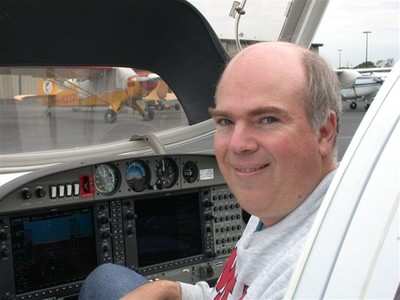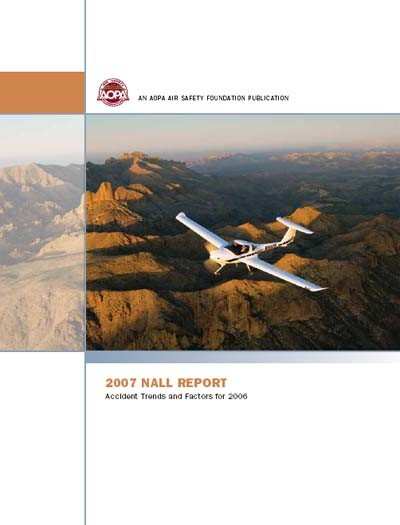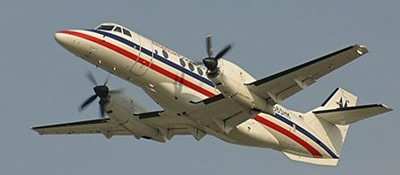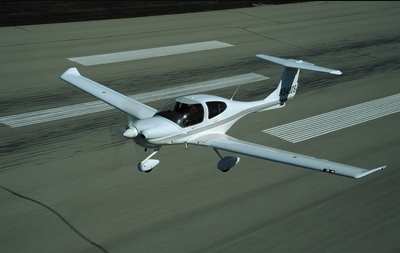Veteran CFI Makes Some Intriguing Suggestions
E-I-C Note: Max Trescott (pictured below),
an experienced CFI, author, and aviation educator, sent the
following missive to us with the hope that the FAA might get the
hint and adopt some of the strategies he suggests... read along and
see if you agree as much as we do with his ideas.

It's time for the FAA to set an aggressive goal, comparable to
the ones they set for airliners, for reducing the general aviation
fatal accident rate. Without one, senseless accidents will
continue, needless lives will be lost, and potential new pilots
will be scared away.
The general aviation safety record has improved over the years
due to the leadership and collaborative efforts of the FAA, the
AOPA Air Safety Foundation (ASF) and other organizations, and more
can be done. From 1997 through 2006, the fatal accident rate
declined from 1.36 to 1.26 accidents per 100,000 hours flown, a
7.4% decrease per the ASF's 2007 Nall Report, an authoritative
summary of GA accident data. The number of fatal general aviation
accidents declined by 5% in 2007, though this figure is directly
affected by year-to-year variations in the number of hours flown.
Historically, much of the decline in the number of fatal accidents
is directly attributable to a decrease in the total number of hours
flown, rather than a decline in the underlying accident rate. Thus
measuring the rate of accidents, as the FAA does for commercial
aviation, gives a more accurate picture of the likelihood of an
accident occurring, versus counting the number of accidents.

However, the current FAA performance measure for general
aviation is still the number of fatal accidents per year. This
figure is one of many measures on the FAA's performance report used
to determine whether the FAA is meeting its goals, and it
influences how much employees are paid. The FAA performance target
for 2008 allows the number of general aviation fatal accidents to
increase by 3%, from 314 accidents in 2007 to 325 accidents in
2008, and still allow the FAA to have a "green" passing grade on
their scorecard. By contrast, their performance target for
commercial aviation is to cut the rate of airline fatalities by 50%
by 2025. Yet, there is no long-term goal for reducing general
aviation accidents.
Background
 In recent years, general
aviation averaged over 300 fatal accidents per year, resulting in
around 600 deaths per year. This is very high compared to air
carrier aviation fatalities, which numbered 40 in 2005. By
comparison, the NTSB reports that annually railroads account for
over 700 fatalities, boating accidents claim over 800 lives, and
car accidents kill over 40,000 people. Nonetheless, while the
public shows little reticence to board a boat or drive a car, they
tend to view small planes as unsafe
In recent years, general
aviation averaged over 300 fatal accidents per year, resulting in
around 600 deaths per year. This is very high compared to air
carrier aviation fatalities, which numbered 40 in 2005. By
comparison, the NTSB reports that annually railroads account for
over 700 fatalities, boating accidents claim over 800 lives, and
car accidents kill over 40,000 people. Nonetheless, while the
public shows little reticence to board a boat or drive a car, they
tend to view small planes as unsafe
In April 1998, then FAA Administrator Jane Garvey (right)
announced, as part of the FAA's Safer Skies Initiative, goals for
reducing general aviation and commercial aviation accidents. The
target for general aviation was to reduce the number of fatal
accidents from 400 to 350, a 12.5% reduction over ten years. A
June, 2000 Government Accounting Office report said that this goal
did "not encourage aggressive steps to decrease general aviation
accidents." By contrast, the goal for commercial aviation was
aggressive. It was to reduce the fatal accident rate by 80% over
ten years, compared to a baseline measurement of accident data from
the years 1996 to 1998.
To be fair, the FAA's current performance target of 325 fatal
accidents for 2008 is high partially because of the larger than
expected decline in the number of accidents in 2007. Still, the
goal should be revised downward. Also, the FAA is planning to
change their general aviation performance target from the number of
fatal accidents to the rate of fatal accidents, and to set a
long-term goal for reducing accidents.
According to the FAA's FY 2008 Performance Target for General
Aviation Fatal Accidents, the FAA hasn't used a rate measure since
that requires an accurate measure of the number of general aviation
hours flown, and in the past that voluntary survey data was
considered unreliable. However, it says that "…a survey was
completed in FY 2004 that, for the first time, creates a
statistically valid report of general aviation activity that the GA
community agrees on. The next step is to create the baseline and
work with the GA community on a reasonable target for the rate."
The 2008-2012 FAA Flight Plan says regarding general aviation fatal
accidents that "The targets for FY 2009-2012 are under
development." A year earlier, the 2007-2011 FAA Flight Plan said
that "The targets for FY 2010-2011 are under development."
Success in Commercial Aviation
While the general aviation accident picture is hazy, commercial
aviation results are clear with unlimited visibility. Ten years
ago, when the FAA set a goal to reduce the rate of commercial
aviation fatalities by 80% by the year 2007, few thought it was
possible. In fact, the goal wasn't reached, but to the surprise of
many however, they did reduce the commercial aviation fatality rate
by more than 60%.

Not content to rest on their laurels, the FAA is poised to
repeat this success with their new goal of reducing the rate of
commercial fatalities 50% by 2025. Obviously, they know that the
higher one sets the bar, the more that is achieved. Even if the
original goal isn't reached, far more is achieved than if a lower,
"more realistic" goal were set.
The Need for New General Aviation Safety Goals
I urge the FAA to immediately set new general aviation accident
performance targets for 2008 and 2009. In private industry, it
would be inconceivable to set targets and pay bonuses for declining
sales or decreasing profits. Likewise, the FAA needs a goal for
decreasing, not increasing general aviation accidents in the next
two years.

The FAA should repeat history and set another aggressive goal,
but this time for general aviation safety. I propose a goal of
reducing the general aviation fatal accident rate by 50% by the
year 2020. With a higher bar, the FAA, industry, and other
organizations will work even harder to find innovative new ways of
achieving the goal.
Unfortunately, there are no easy fixes or silver bullets for
attaining this goal. However, here are a few ideas.
1) Educate pilots on the greater risks involved
in night flying. Less than 5% of flying is at night, yet 21% of
fatal accidents are at night.
2) Identify unique regional risk factors and
communicate them to airmen in each region, as I proposed to FAA
Administrator Blakey. For example, my analysis of fatal accidents
from 1993 through 2004 for the San Francisco Bay area showed that
the fatal accident rate at night was 2.5 times the national average
and VFR-into-IMC accidents occurred at a rate 6 times the national
average.
3) For the Private Pilot checkride, modify the
test criteria (the FAA's Private Practical Test Standard) to
include knowledge of somatogravic illusion and black hole
approaches, which are major contributors to night accidents. Test
for knowledge of local accident risk factors and require a
discussion of the personal minimums the new pilot will use after
attaining his or her certificate.
4) Develop an online, interactive risk
management tool for pilots to enter a profile of their experience,
location, and proposed trip information to generate a risk
assessment and recommendations.
5) Develop a hotline pilots can call to talk
with a flight instructor to evaluate risk prior to a flight.
6) Consider adding knowledge requirements in
accident risk factors to the flight instructor rating.
7) Add Global Forecast System (GFS) charts to
the www.aviationweather.gov
website and educate pilots on how to interpret these charts to
avoid icing conditions.
8) Apply human factors analysis to current FAA
procedures governing aircraft movements on the ground and in the
air. For example, pilots sometimes confuse the ATC instructions
"Hold Short" and "Position and Hold" since they both contain the
word "Hold." In some countries, the latter instruction has been
replaced with "Line up and Wait" to avoid confusion.
Achieving a 50% reduction in the general aviation fatal accident
rate isn't easy and will be harder than similar reductions in
commercial aviation. However, if we achieve only a 40% reduction,
we'll save several thousand lives. To not set aggressive short and
long-term goals is unconscionable when so many lives are at
stake.
 ANN's Daily Aero-Linx (04.16.24)
ANN's Daily Aero-Linx (04.16.24) Aero-News: Quote of the Day (04.16.24)
Aero-News: Quote of the Day (04.16.24) Airborne 04.10.24: SnF24!, A50 Heritage Reveal, HeliCycle!, Montaer MC-01
Airborne 04.10.24: SnF24!, A50 Heritage Reveal, HeliCycle!, Montaer MC-01 Airborne 04.12.24: SnF24!, G100UL Is Here, Holy Micro, Plane Tags
Airborne 04.12.24: SnF24!, G100UL Is Here, Holy Micro, Plane Tags Airborne-Flight Training 04.17.24: Feds Need Controllers, Spirit Delay, Redbird
Airborne-Flight Training 04.17.24: Feds Need Controllers, Spirit Delay, Redbird







